
Vol. XXI, No. 2, February 2021
The potential post-pandemic impact working from home will have for out-of-home entertainment and arts
It was back in his December 23 blog that Randy White, our CEO, discussed how when the coronavirus is no longer a concern, higher socioeconomic workers will continue to work from home (WFH), also known as teleworking or remote work. As a result, they will have more leisure time since they won't need to commute, possibly resulting in some of that additional leisure time being used to attend out-of-home entertainment and arts (OOH E&A). That is especially significant, as higher socioeconomic adults represented nearly three-quarters of all spending for fees and admission at OOH E&A in 2019. Yet, of all socioeconomic groups, the higher socioeconomic, those adults with a bachelor's or higher degree, have the least amount of leisure time. Pre-Covid, bachelor's+ adults had nearly 1.5 hours less leisure time per day (86 fewer minutes) than high school-only graduates and 51 fewer minutes than adults with some college. So even a small increase in their available leisure time could positively impact their participation in OOH E&A in the post-Covid era.
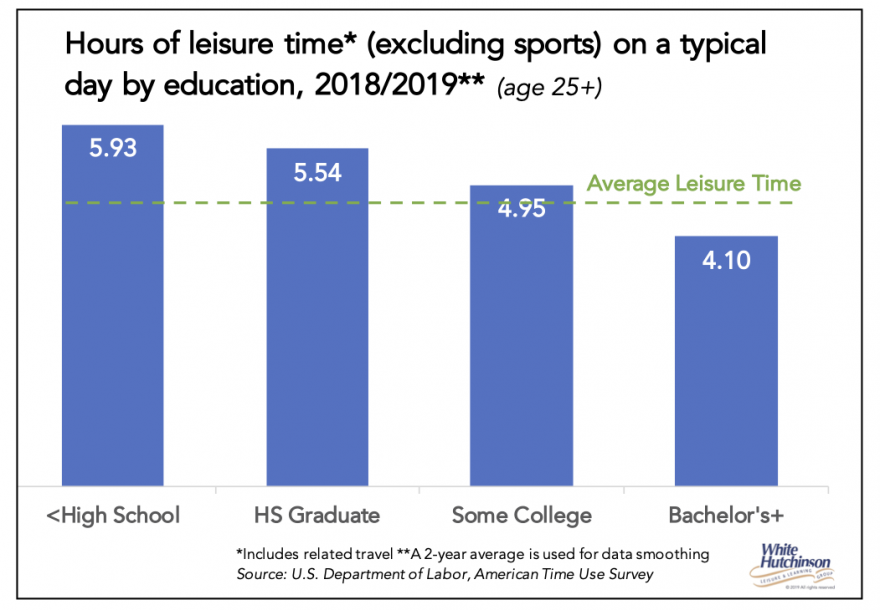
We now have some new data on telework. It seems that higher socioeconomic workers previously spent more time commuting than Randy estimated back in December. Research shows that commuting time increases with incomes up to around $200,000. Bachelor's degree adults had a median income of $105,000 in 2019. Higher-degree adults had a median income of $144,000. The average one-way commute time for adults with $120,000 incomes was approximately 36 minutes in 2019, 9 minutes greater than Randy estimated initially. That results in a commute savings of more than one hour a day (72 minutes), increasing available leisure time for WFH bachelor's+ adults to nearly equal that of high school-only graduates.
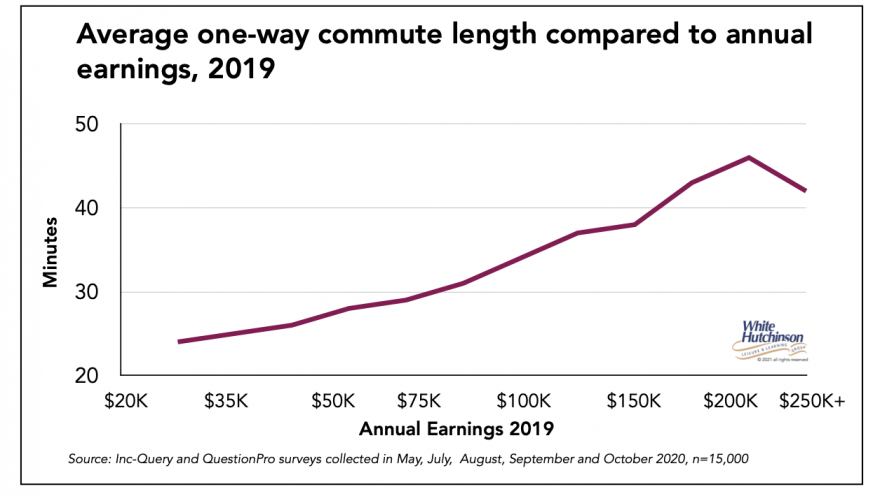
There's also new data from the U.S. Census Bureau Pulse Survey on who was teleworking in early January 2021. It found that 38% of adult workers have substituted some or all of their typical in-person paid work for telework due to the pandemic. As shown in the chart below, most of those working from home were the higher socioeconomic, those with a bachelor's or advanced degree.
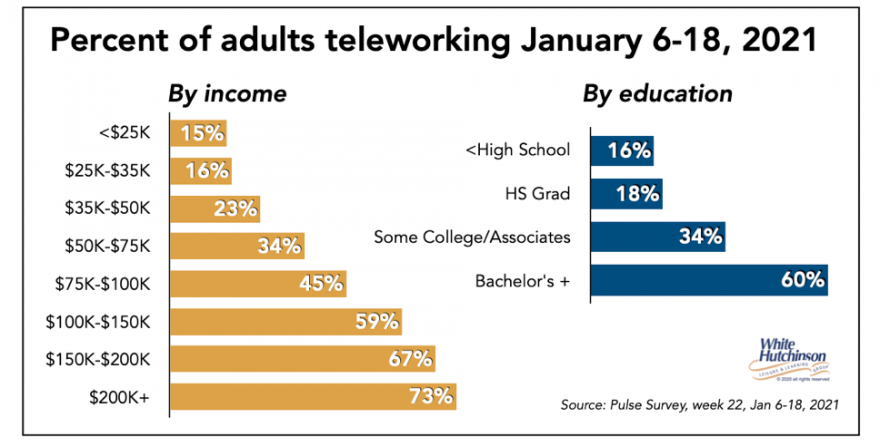
A December research paper, Why Working From Home Will Stick *, found 22% of all paid full workdays would occur at home after the pandemic ends, compared with just 5% before.
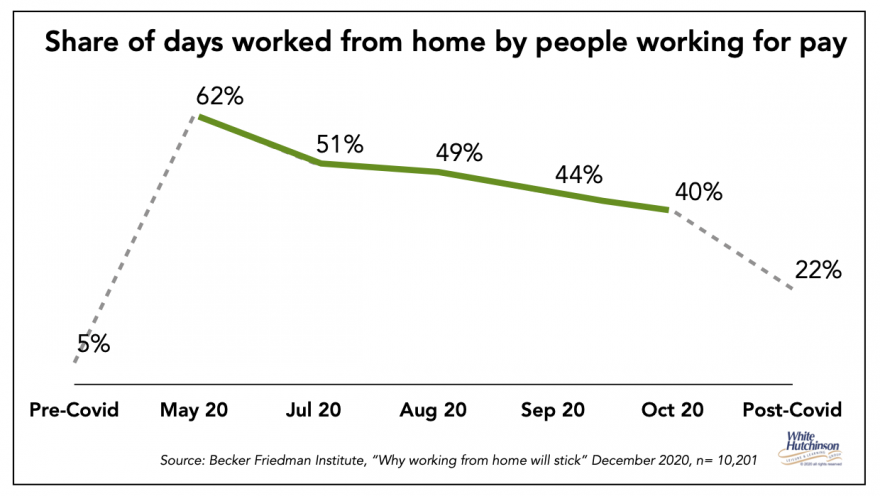
A December 14-15, 2020 poll of 1,411 adults conducted for HealthCareInsider.com found approximately one-quarter of adults expect the Covid-19-related trend of increased work from home is a trend likely to stay. 37% of adults in households earning $80,000 or more identified working from home as the Covid-related trend most likely to continue, compared to 26% of those with $40,000-$80,000 in income, and just 20% with incomes under $40,000.
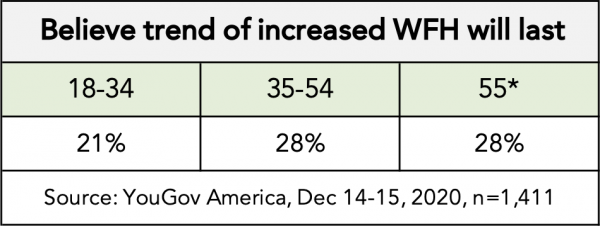
McKinsey & Company predicted WFH would be highly concentrated among highly educated workers, as is the case now.
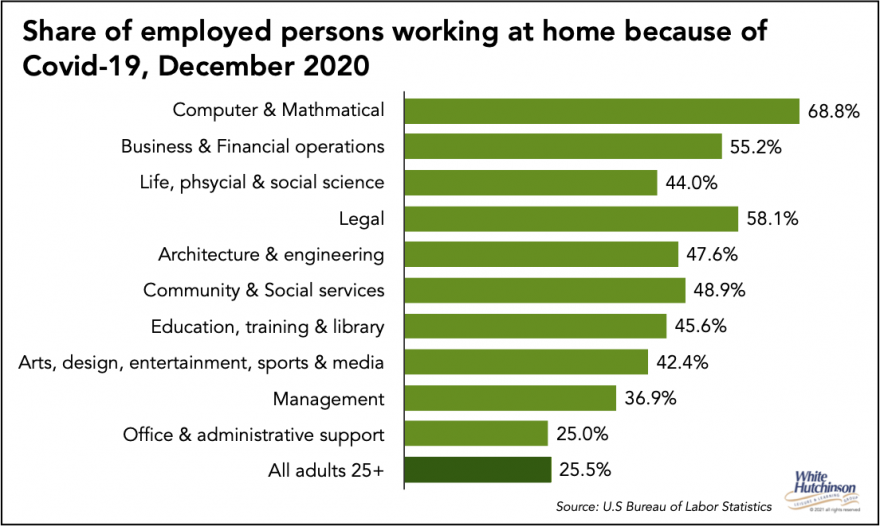
The Why Working From Home Will Stick research found that there are five primary reasons why remote work will continue post-pandemic:
- WFH now has a reduced stigma and is considered highly acceptable.
- The pandemic forced both workers and firms to experiment with WFH en masse, giving them a chance to learn how well it actually works.
- The average worker has invested over 13 hours and about $660 in equipment and infrastructure at home to facilitate working from home. Also, firms have made sizable investments in back-end information technologies and equipment to support WFH.
- About 70% of workers express a reluctance to return to some pre-pandemic activities even when a vaccine for Covid-19 becomes widely available, for example riding subways and crowded elevators, or dining indoors at restaurants. This persistent fear of proximity to others is likely to leave some residual demand for social distancing at workplaces and prop up demand for working from home in the future.
- The rate of innovation around technologies that facilitate work from home has accelerated. The massive expansion in working from home has boosted the market for WFH equipment, software, and technologies, spurring a burst of research supporting working from home, especially remote interactivity.
We have an October 2020 survey on what workers are doing with the time they're saving from not commuting when working from home.
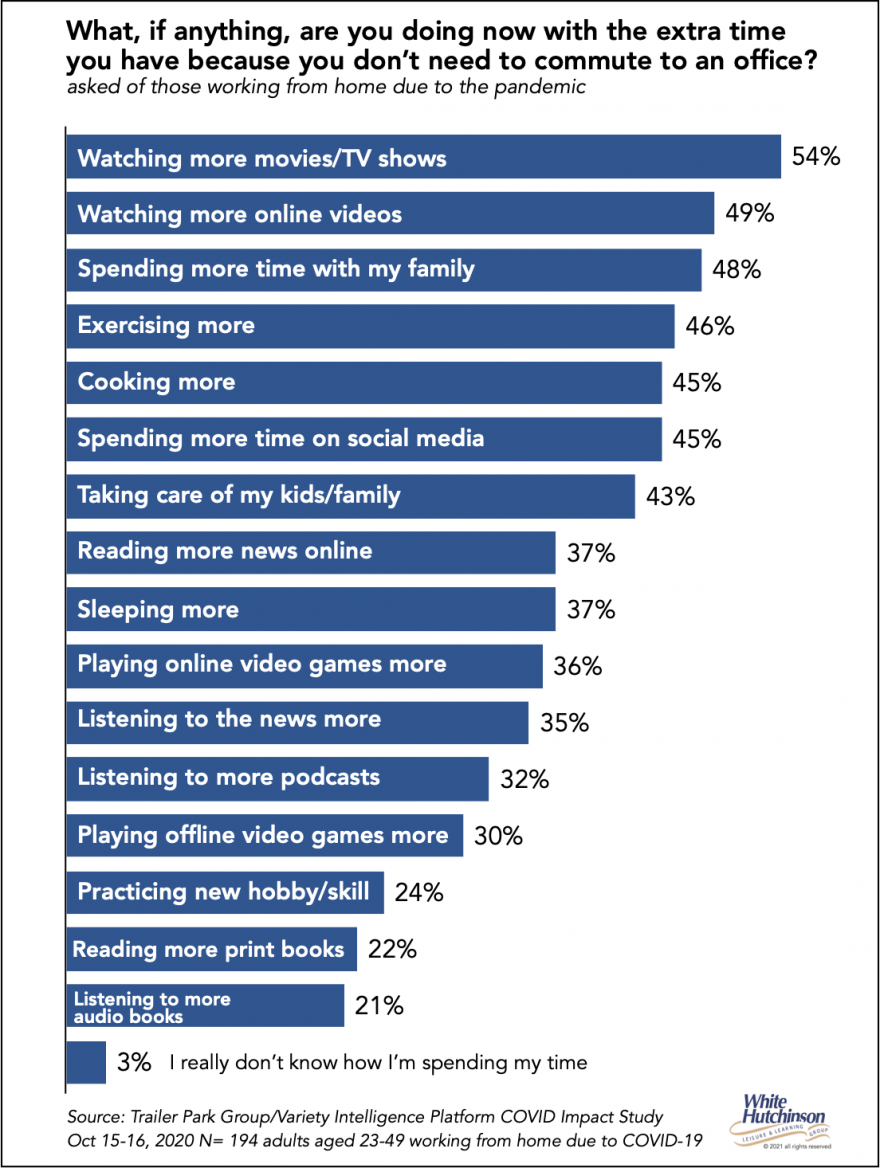
Watching TV, movies, and online videos was the most increased activity. Seven other digital activities are also listed, with digital leisure activities the vast majority of activities. Cooking more and practicing new hobbies and skills are also replacing some of the commute time. Besides sleeping more and taking care of kids/family, all the time saved from not commuting was being used for leisure activities.
Of course, this October survey was conducted when people are predominately staying home and not attending OOH E&A due to fear of the coronavirus or that many venues are closed. Although the cooking and hobbies might have some sticking power when concern about getting infected is no longer a consideration for going out, it is likely some of the increased leisure time spent with digital entertainment might be displaced by time spent revisiting OOH E&A. Since the higher socioeconomic, who will represent the largest share of increased WFH, are gaining the greatest increase in leisure time from less commuting and have higher discretionary dollars, this could bode well for OOH E&A in the post-pandemic era.
If we assume that the post-pandemic WFH rate will be 22% of all paid workdays compared to 5% pre-Covid, as the research paper found, and that the distribution of WFH by education will be consistent with its present distribution in early January, that will equate to the following post-pandemic percentages of WFH days and increases to WFH days for workers by education.
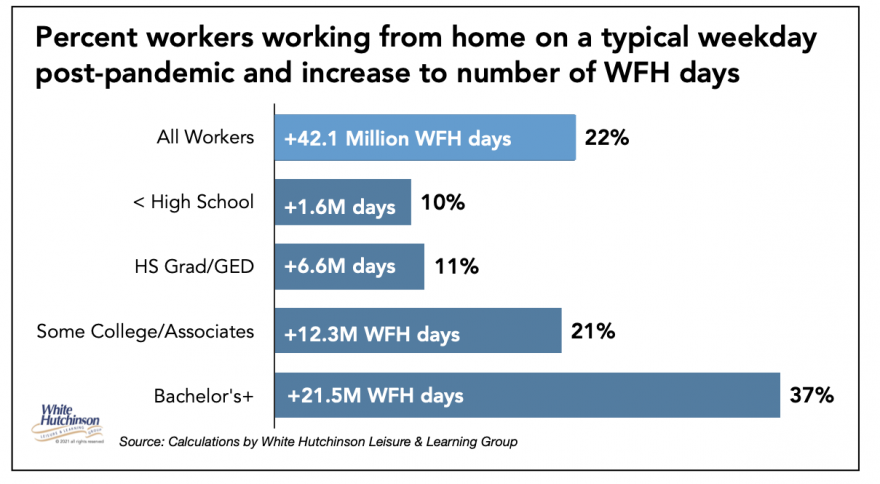
Based on the December 2020 total number of workers at each educational level, this will result in the equivalent of 21.5 million more bachelor's+ workers teleworking in the post-pandemic era. That equates to 25.8 million more hours each day saved from not commuting by those college-degreed workers.
Not all WFH will be continuous every day of the week. It is much more likely to be a hybrid situation. Assuming the saved time is distributed across all bachelor's+ workers (each is working from home around one day a week), that would mean each worker will gain on average 19 minutes more time each day.
In 2019, bachelor's+ adults spent an average of 7.2 minutes a day, nearly 3% of their total of 4.1 hours of daily leisure time attending OOH E&A.
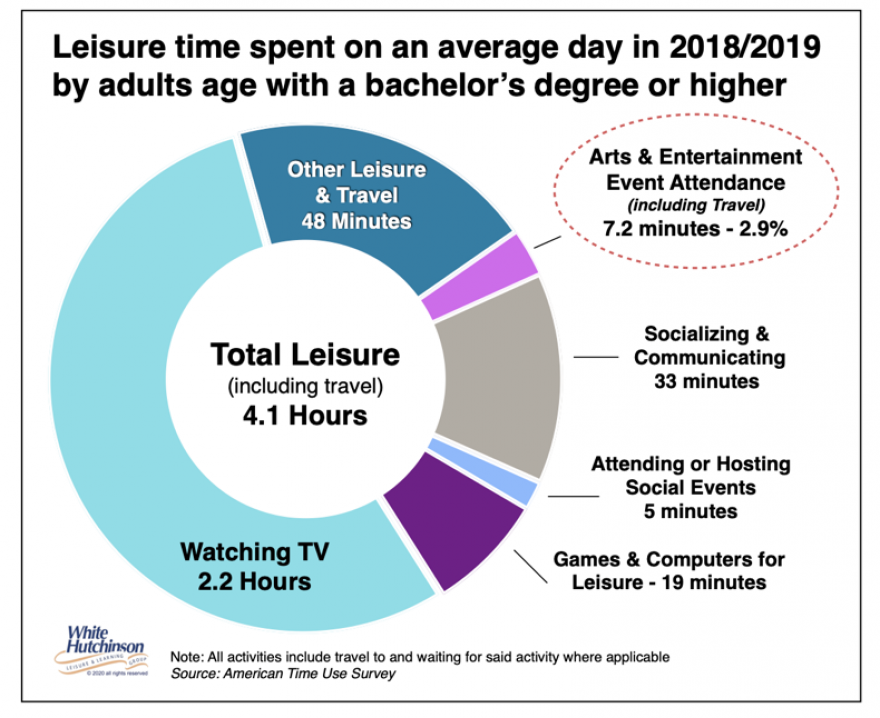
The percentage of all paid workdays spent at home by bachelor's+ workers increasing post-pandemic from 5% to 22% results in a total of over 25 millionw additional saved hours a day. If we assume the saved time will be used for leisure, and as in the past, only 2.9% is devoted to OOH E&A, that results in an increase of nearly 750,000 hours at OOH E&A each day, or 180 million additional hours per year.
However, the saved time from not commuting takes place during the week. Pre-Covid, only 49% of time spent at OOH E&A took place during the week, or around 10% per day. Slightly over half (51%) took place on weekends, about 25% per day, when people could use their leisure time all day and into the night. So, it is not likely that the additional weekday time savings will be used for OOH E&A at the 2.9% rate. More likely around half of that rate, resulting in 90 million extra hours of OOH E&A each year.
Using an average length-of-stay of 2.5 hours, including travel, results in an increase of nearly 36 million more visits a year to OOH E&A. Using an average annual attendance of 200,000 per venue means that increase could support 180 venues.

There's a significant caveat to the above assumptions. Rather than using the saved time from not commuting for leisure and other non-work activities, WFH workers might use it to work longer hours. That has been the trend during the pandemic. Astudy in July 2020 by the National Bureau of Economic Research found teleworkers had an average 48-minute increase in the length of the average workday. An October 2020 Pew Research Center survey found that one-third of adults working from home all or most of the time are working more hours than they did before the pandemic. Nearly 70% of professionals who transitioned to remote work because of the pandemic said they worked on the weekends, and 45% said they regularly worked more hours during the week than they did before, according to a recent survey of 2,800 workers by staffing firm Robert Half.
There could be several reasons that some workers are working longer hours since teleworking. Many workers are still learning how to manage the boundaries between work and life when both take place at the same location, especially when life is restricted to home during the pandemic. It becomes easy to overwork when there is a blurred distinction between the physical locations for work and personal life. A survey by buffer.com conducted October 14, 2020 - January 4, 2021, found that the top struggle remote workers said they were having was not being able to unplug. Fear and uncertainty about the economy and job security could be driving people to work longer hours as well.
Experts agree that a longer workday is not sustainable. Many companies are starting to encourage employees to better manage the amount of time they work.
Research by NordVPN has found an increase in the average workday in the U.S., Canada, and the U.K., including indications of shorter lunch breaks while working remotely. However, they found that employees in Denmark, Belgium, and Spain initially recorded a spike in working hours but have since returned to their pre-pandemic timetable. We could see the same trend occur in North America and the U.K as workers improve their work/life balance management.
Many companies are giving their remote workers flexibility on their work hours. This can allow workers more freedom during weekdays to attend OOH E&A. The buffer.com survey found that remote workers' top-rated benefit of working remotely was the ability to have a flexible schedule. The Pew Research Center survey found that four-in-ten adults working from home all or most of the time said they have more flexibility to choose their hours now than before the coronavirus outbreak.
One possible result for many bachelor's+ remote workers is that they might move further away from their home offices with their teleworker freedom. A survey by hireahelper.com found that 28% of people who moved in 2020 moved because they started working from home and no longer had to live close to work. Some may occasionally still need to visit the office, but less frequently than before, which will then be a longer commute than before they moved.
Of course, less-educated workers will also gain some leisure time by working from home more and not commuting. However, the increased number of workers working from home is less, and as is their share and amount of leisure time spent at OOH E&A as compared to bachelor's+ workers. Pre-pandemic, less-educated households only accounted for about one-quarter of all spending for fees and admissions to OOH E&A.
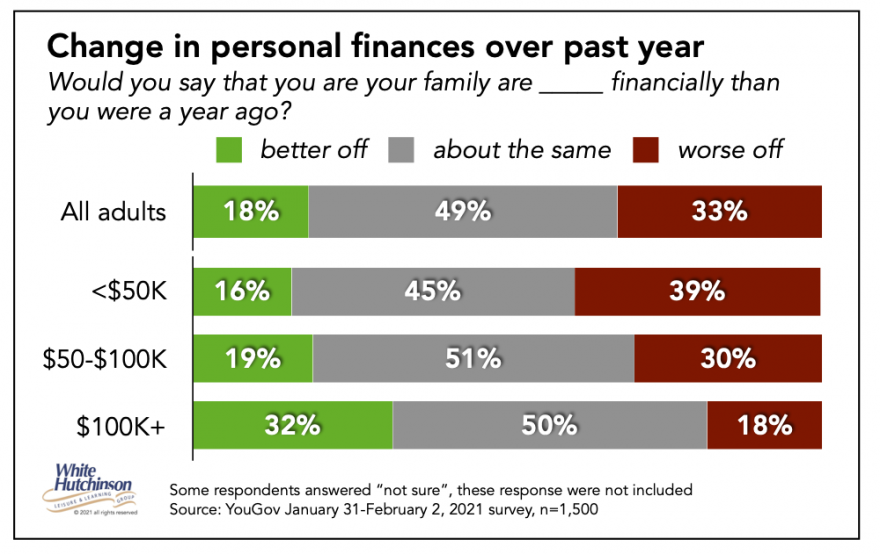
Although bachelor's+ remote workers might increase attendance at OOH E&A, it should be remembered that many workers are having financial difficulties during the pandemic, which will likely depress any discretionary spending and attendance at OOH E&A for many years.
The loss of business from them might be greater than the gain from bachelor's+ teleworkers.
The pandemic has been an accelerant to the long-term trend of the growing bifurcation, the gentrification of OOH E&A. Due to increased WFH, the higher socioeconomic, those adults with a bachelor's or advanced degree, and those households headed by one, are likely to represent an even greater share of the post-pandemic OOH E&A market than the three-quarter share (74%) in 2019. Also contributing to the growing bifurcation is that the OOH E&A market may lose many less educated and middle and lower socioeconomic customers due to the long-term impact of their economic difficulties during the pandemic. They proportionally are having greater financial challenges than the higher socioeconomic and college-educated workers.
The increased WFH trend might have an adverse impact on OOH E&A located in urban areas with large concentrations of offices. The Why Working From Home Will Stick research paper estimated that the post-pandemic shift to WFH will lower post-Covid worker expenditures on meals and entertainment in central business districts by 5 to 10%.
There can be little doubt that the projected continuation of the increased WFH will impact workers' leisure time and how they use it. It will also change the OOH E&A market potential in many areas, especially in central business districts.
* Barrero, J. M., Bloom, N., & Davis, S. J. (2020). Why Working From Home Will Stick . University of Chicago, Becker Friedman Institute for Economics Working Paper , (2020-174)


